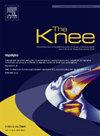人工关节计与机械关节计在ACL重建患者恢复运动时记录的前膝关节松弛度的比较
IF 2
4区 医学
Q3 ORTHOPEDICS
引用次数: 0
摘要
背景:心率计是通过量化胫骨股骨前移位来评估膝关节松弛程度的装置。本研究的目的是评估人工和机械膝关节计在前交叉韧带重建(ACLR)患者中胫骨股骨位移测量的一致性。方法对22例行ACLR患者44条肢体进行评估。所有受试者在入组前均已获准重返运动。在同一次访问中,参与者接受了手动和机械关节计对膝关节前松度的评估。评估受累和未受累肢体。评估关节计之间原始膝关节松弛测量的幅度、装置间关联以及肢体测量的秩序显著性。不同的术后训练方案对器械测量的影响也进行了评估。结果机械关节计在134 N和手动关节计在89 N时,受累肢体和未受累肢体的平均胫骨股骨位移测量值具有可比性(P = 0.33),然而,两种关节计在134 N时的平均位移值差异显著(P < 0.01)。总的来说,没有观察到机械和手动关节计测量之间的显著关联。在Side和Device的比较中,秩序差异趋向于较低(P > 0.06)。在本研究中没有观察到机械关节计和手动关节计的一致性。结论采用多种关节计的多中心研究或文献综合应侧重于报告delta值,因为目前的数据显示装置之间没有显著的重复测量delta。本文章由计算机程序翻译,如有差异,请以英文原文为准。
Comparison of anterior knee laxity measurements recorded by manual versus mechanical arthrometers in ACL reconstruction patients at return to sport
Background
Arthrometers are devices used to evaluate knee laxity by quantifying anterior tibiofemoral displacement. The purpose of this study was to assess the congruence of tibiofemoral displacement measurements between manual and mechanical knee arthrometers in anterior cruciate ligament reconstructed (ACLR) patients.
Methods
This investigation evaluated 44 limbs in 22 subjects who underwent ACLR. All subjects were cleared for return to sport prior to enrollment. Participants underwent manual and mechanical arthrometer assessments of anterior knee laxity in the same visit. Both involved and uninvolved limbs were assessed. The magnitude of raw knee laxity measurements between arthrometers, inter-device associations, and rank-order significance of limb measurements were assessed. The impact of different post-operative training protocols on device measurements was also evaluated.
Results
Mean tibiofemoral displacement measurements for involved and uninvolved limbs were comparable for the mechanical arthrometer at 134 N and manual arthrometer at 89 N (P = 0.33), however, mean displacement values varied significantly between the two arthrometers at 134 N (P < 0.01). Overall, significant associations between mechanical and manual arthrometer measurements were not observed. Rank order trended toward lower difference when comparing Side and Device (P > 0.06). Consilience between mechanical and manual arthrometers was not observed in this investigation.
Conclusions
Multi-center studies or literature syntheses that incorporate more than one type of arthrometer should focus on reporting delta values as the present data demonstrated no significant repeated measures deltas between-devices.
求助全文
通过发布文献求助,成功后即可免费获取论文全文。
去求助
来源期刊

Knee
医学-外科
CiteScore
3.80
自引率
5.30%
发文量
171
审稿时长
6 months
期刊介绍:
The Knee is an international journal publishing studies on the clinical treatment and fundamental biomechanical characteristics of this joint. The aim of the journal is to provide a vehicle relevant to surgeons, biomedical engineers, imaging specialists, materials scientists, rehabilitation personnel and all those with an interest in the knee.
The topics covered include, but are not limited to:
• Anatomy, physiology, morphology and biochemistry;
• Biomechanical studies;
• Advances in the development of prosthetic, orthotic and augmentation devices;
• Imaging and diagnostic techniques;
• Pathology;
• Trauma;
• Surgery;
• Rehabilitation.
 求助内容:
求助内容: 应助结果提醒方式:
应助结果提醒方式:


